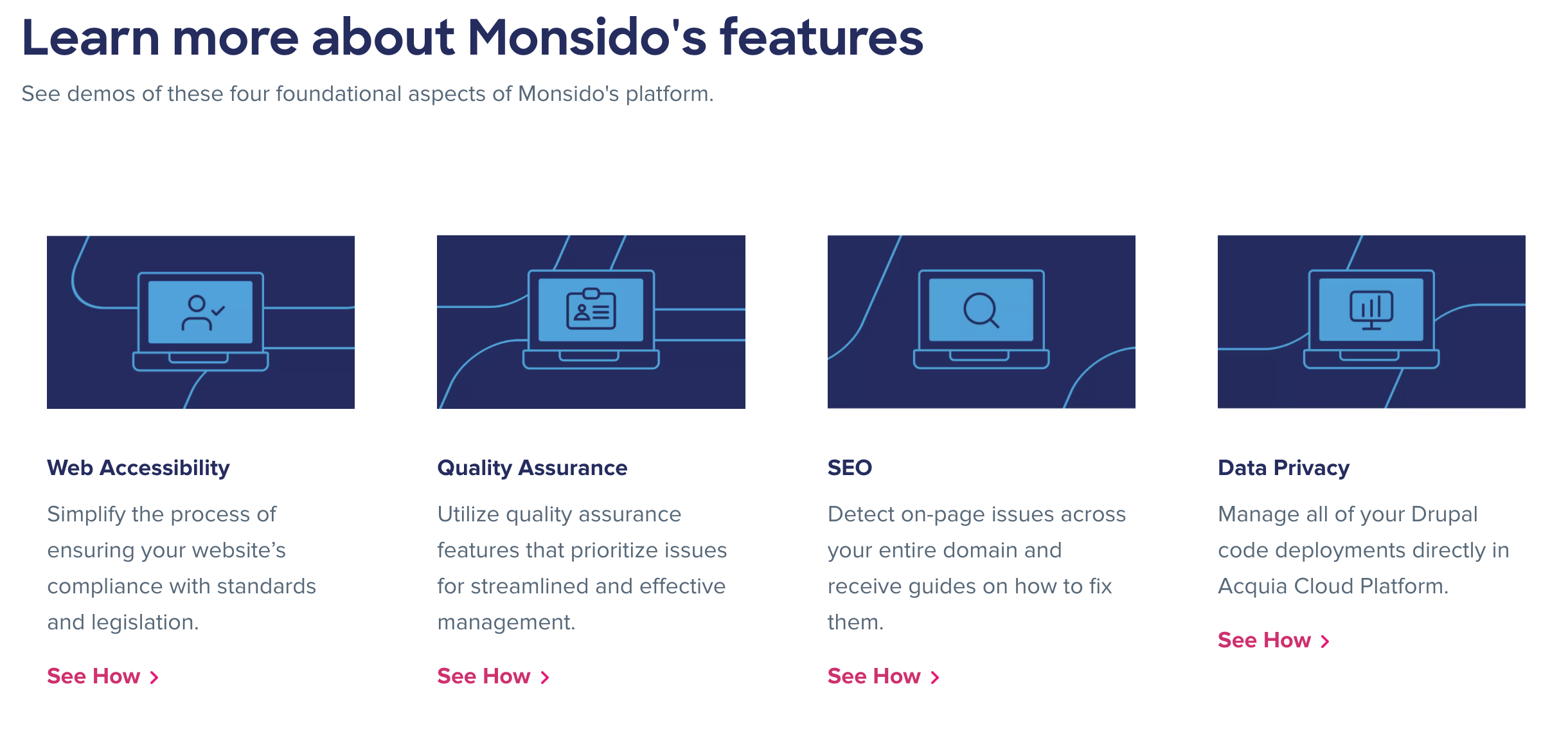Embracing the New Era of Web Accessibility with WCAG 2.2 Enhancements
- 6 minute read
-
In the dynamic realm of digital accessibility, the release of the Web Content Accessibility Guidelines (WCAG) 2.2 on October 5, 2023, marks a significant milestone. This update from the World Wide Web Consortium (W3C) not only enhances the inclusivity of the internet but also introduces pivotal changes aimed at improving web accessibility for individuals with cognitive disabilities and optimizing user experience on touchscreen devices.
With the evolution of WCAG from its 2018 version 2.1 to the current 2.2, there is a clear signal towards a more inclusive and user-friendly digital environment for all.
Understanding the critical importance of staying updated with these guidelines, Acquia’s Optimize product has introduced a groundbreaking feature in its Optimize Platform: the Accessibility Module. This module is designed to align websites with the newly established WCAG 2.2 standards, ensuring that digital content is accessible to a broader audience, including those with diverse abilities.
Read Acquia’s Press Release.
Significance of WCAG 2.2
WCAG 2.2 builds on the foundation laid by version 2.1, introducing additional success criteria specifically targeting cognitive disabilities and enhancing the user experience on touchscreen devices. These updates are crucial as they address the evolving needs of internet users and the widespread adoption of mobile technology. By focusing on cognitive disabilities, WCAG 2.2 acknowledges the diverse ways in which people perceive, understand, and navigate web content, paving the way for more inclusive digital experiences.
What’s Improved in WCAG 2.2
WCAG 2.2 provides 9 additional success criteria since WCAG 2.1. Here is a quick snapshot of each policy, what it means, and a simple suggestion or two on how site owners and developers can satisfy the requirement.
- 2.4.11 Focus Not Obscured (Minimum) (AA) - Ensure that when an item gets keyboard focus, the focus is at least always partially visible.
- 2.4.12 Focus Not Obscured (Enhanced) (AAA) - Improves on 2.4.11, ensuring that the entirety of the focus indicator must be accessible.
- 2.4.13 Focus Appearance (AAA) - Use an outline or other significant indicator around the perimeter of a focused element that is at least 2 CSS pixels thick and has sufficient contrast.
- 2.5.7 Dragging Movements (AA) - Make sure that there is a way for a mouse/touch user to still perform the same action using simple clicks/taps, rather than being forced to perform a dragging movement.
- 2.5.8 Target Size (Minimum) (AA) - Design your ui to ensure that targets are at least 24 by 24 CSS pixels or use enough spacing to allow for accessibility.
- 3.2.6 Consistent Help (A) - Design your ui and functionality so that the help resources are consistently available considering placement and functionality.
- 3.3.7 Redundant Entry (A) - If used, design your ui and functionality so that users won’t have to re-enter the same information multiple times as part of a process.
- 3.3.8 Accessible Authentication (Minimum) (AA) - In brief, don’t require cognitive function tests (like a math problem) as part of a captcha step or other authentication process.
- 3.3.9 Accessible Authentication (Enhanced) (AAA) - This builds on 3.3.8 and removes the exception for "object recognition" such as the human verification of “select all of the crosswalk images”. To reach 3.3.9, those puzzles cannot be used.

Optimize Platform's Accessibility Module: A Game Changer
Optimize's Accessibility Module stands at the forefront of this transformative journey towards enhanced web accessibility. With its capability to scan and evaluate web content based on the WCAG 2.2 criteria, this module empowers website owners and content creators to identify and rectify accessibility issues, thereby making their sites more inclusive.
For existing Optimize customers, the transition to WCAG 2.2 is seamless. The platform has supported the draft version of WCAG 2.2, ensuring that customers who were already aligning their content with the draft standards are automatically updated to the official WCAG 2.2 criteria.
This proactive approach by Optimize underscores its commitment to promoting digital accessibility and supporting its customers through every stage of web accessibility compliance.
Embracing WCAG 2.2 with Optimize
Switching to the WCAG 2.2 scanning criteria with Optimize's Accessibility Module offers a plethora of benefits:
- Enhanced Accessibility: By adhering to the latest guidelines, websites can cater to a wider audience, including individuals with cognitive disabilities and those using touchscreen devices.
- Improved User Experience: The focus on touchscreen optimization and cognitive accessibility ensures that all users enjoy a more engaging and navigable online experience.
- Compliance and Reputation: Aligning with internationally recognized standards not only ensures legal compliance but also enhances the reputation of businesses as inclusive and forward-thinking entities.

The release of WCAG 2.2 is a call to action for website owners and digital content creators to embrace a more inclusive approach to web design and content delivery. Optimize's Accessibility Module is an invaluable tool in this journey, offering a robust solution for achieving compliance with the latest web accessibility standards. By leveraging this feature, Optimize customers can ensure that their digital content is accessible to all users, thereby fostering a more inclusive internet for future generations.
Read more:
- Acquia/Drupal and Optimize
- Watch an intro webinar
- The Path to Building Accessible Applications
- Download the free Web Accessibility Handbook
For more on Optimize and Accessibility with your Drupal applications talk to your account manager or reach out to Acquia Support.






